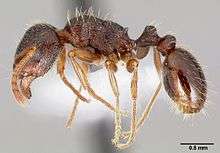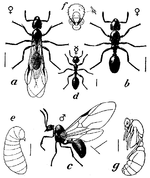Pavement ant
| Pavement ant | |
|---|---|
 | |
| Tetramorium caespitum worker | |
| Scientific classification | |
| Kingdom: | Animalia |
| Phylum: | Arthropoda |
| Class: | Insecta |
| Order: | Hymenoptera |
| Family: | Formicidae |
| Subfamily: | Myrmicinae |
| Genus: | Tetramorium |
| Species: | T. caespitum |
| Binomial name | |
| Tetramorium caespitum | |
The pavement ant (Tetramorium caespitum) is an ant native to Europe, which also occurs as an introduced pest in North America. Its common name comes from the fact that colonies in North America usually make their homes under pavement. It is distinguished by one pair of spines on the back, two nodes on the petiole, and grooves on the head and thorax.[1]
During the late spring and early summer, colonies attempt to conquer new areas and often attack nearby enemy colonies. This results in huge sidewalk battles, sometimes leaving thousands of ants dead. Because of their aggressive nature, they often invade and colonize seemingly impenetrable areas outside their native range.
In summer, the ants dig out the sand between the pavements to vent their nests.

Pavement ants were studied on the International Space Station in 2014.[2]
Description
The pavement ant is dark brown to blackish, and 2.5–4 mm long. Like other ants there are the workers, alates, and a queen. Workers do have a small stinger, which can cause mild discomfort in humans but is essentially harmless. Alates, or new queen ants and drones, have wings, and are at least twice as large as the workers.
The drone's only job is to mate with the virgin alates, and reproduction is at its highest in spring and summer. Tetramorium, like many other ants, have nuptial flights: drones fly high and mate with new queens. The dealate, or newly fertilized alate, finds a suitable nesting location and digs a founding chamber called the clausteral chamber/cell. As the eggs hatch and the ants develop, they spend that time, about two to three months, tending to the queen of their colony. They will continue helping in the colony until they are a month old.
Older workers hunt and defend the colony. They will eat almost anything, including other insects, seeds, honeydew, honey, bread, meats, nuts, ice cream and cheese. They are also predators of codling moth larvae.[3] The pavement ant serves as host to the workerless and ectoparasitic Tetramorium inquilinum.[4]
References
- ↑ "Pavement ant — Tetramorium caespitum". University of California, Davis. 2004-01-26.
- ↑ "Ants Hold Their Own Searching in Space", Discovery News, March 31, 2015
- ↑ Tadic, M. (1957). The Biology of the Codling Moth as the Basis for Its Control. Univerzitet U Beogradu.
- ↑ Wilson, Edward O. (1963). "The social biology of ants". Annual Review of Entomology. 8: 345–368. doi:10.1146/annurev.en.08.010163.002021. Retrieved March 27, 2017.
External links

- National Pest Management Association. "Pavement Ant Fact Sheet". with information on habits, habitat and prevention
- Steve Jacobs, Sr. Extension Associate. "Pavement Ant". College of Agricultural Sciences, Entomology. Penn State University.